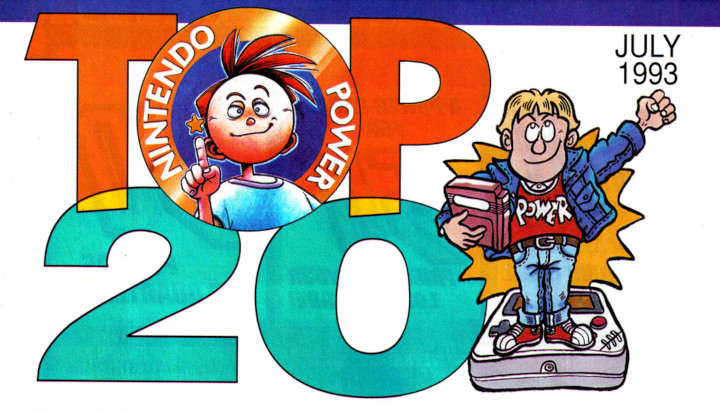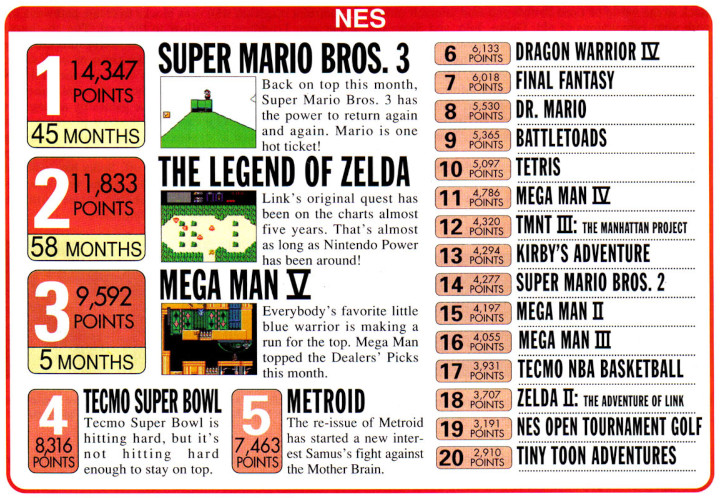A Deeper Dive into Nintendo Power’s Top 20 Scoring System
A while back, I wrote an article called “How Did Nintendo Power’s Top 20 Scoring System Work?” That article explored the Top 20 games lists that were featured in Nintendo Power magazine and attempted to find out how the scoring system was tallied. I was able to show reader surveys, which was one of the sources for these numbers, but I wasn’t able to get any deeper than that. I hit a wall.
And then some readers complained. Why did I stop at this dead end instead of doubling back and trying to find more sources of information? The truth is that I looked everywhere I could think of, and I still came up empty. This is mainly due to the fact that Retrovolve’s Nintendo Power collection is not as complete as I’d like it to be.
Even so, those readers were right to complain. Retrovolve isn’t a site that stops when it hits dead ends. When I wanted to know more about Bubsy 3D‘s infamous review scores, for example, I personally reached out to Michael Berlyn, creator of Bubsy, and we talked for more than an hour. After that, I spent almost a year chasing down a particularly hard-to-find issue of PSExtreme magazine. And when I wanted to learn more about an arcade game called Wiz, I jumped into an incredibly deep rabbit hole and learned a tremendous amount of information about the arcade cabinet manufacturing scene.
So when Retrovolve readers get frustrated that I gave up before getting to the bottom of something, that’s because their expectations for this site are really high — as they should be.
Thankfully, these readers are incredible. Because of the comments section on that Nintendo Power article, I was able to find more information about the Top 20 scoring system. So now that I’m armed with better info, it’s time to delve back into this topic.
First up, some context. In Nintendo Power in the 1980s and early 1990s, there were game rankings in (almost) every issue. They looked like this:
There would be a rank and point value for all 20 games on each list, as well as a number of months for the top three.
In the previous article, I pointed to Nintendo Power‘s survey cards, which asked readers to rank their favorite games to be entered into a drawing where they could win big prizes (read that article if you want to know more about the Player Poll cards and prizes). This gave me the first clue about where the point values came from.
However, since then, I was pointed to a 2008 blog post that collects every NES list from the very first issue of Nintendo Power until the end of 1994 (the magazine would stop featuring NES lists at that point, though SNES and Game Boy both have lists in issue #68, which is the first issue of 1995). Interestingly enough, Issue #50 actually has a full explanation of how these scores are tallied:
Each month we collect information from three sources to find the Top 20. The Players’ Picks come from the Player’s Poll cards sent in each month, the Dealers’ Picks are based on retail sales reports, and the Pros’ Picks are collected from game evaluators at Nintendo. All three sets of votes are set at equal weight, then averaged to find the point total a game receives.
So the point totals don’t only reflect survey responses, but retail numbers and scores provided by “game evaluators at Nintendo.” There were three categories that were combined to create these point values.
As for the month totals, this seems to be how many months the game had appeared on the list. Even though those numbers were only displayed for the top three games on the list, they refer to how many times the game had been in any position on the list. As I pointed out in my previous article, there seem to be a lot of typos in these month values.
And I think that answers all of the questions I had about Nintendo Power‘s Top 20 lists. Thanks to the crowdsourcing of our readers, Retrovolve was able to get to the bottom of yet another retro gaming mystery.



